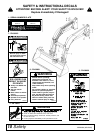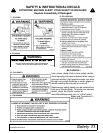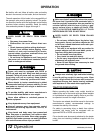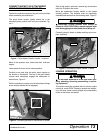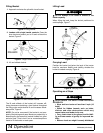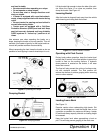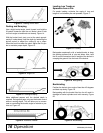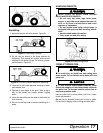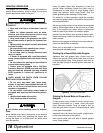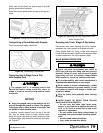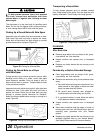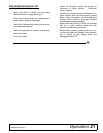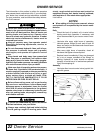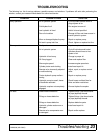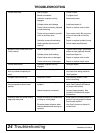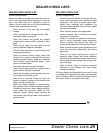
18 Operation
MAN0556 (9/21/2007)
GRAPPLE OPERATION
The grapple fork is a clamping device and should be
used to clamp loose hay, straw, or silage. It is not to be
used to dig material loose from a pile.
AVOID INJURY OR DEATH FROM ROLLOVER
ACCIDENTS:
• Move and turn tractor at less than 6 mph (10
km/h).
• Watch for hidden hazards such as holes,
ditches, and other obstructions which may
cause tractor and loader to tip over.
• Carry loads close to the ground to aid visibil-
ity and lower center of gravity for improved sta-
bility.
• Balance loads so weight is evenly distributed
and load is stable.
• Be extra careful when operating on a slope.
• Do not operate on steep slopes.
• Do not stop, start or change directions sud-
denly on slopes.
• If loader is equipped with round bale attach-
ments, always approach bale with tractor facing
uphill.
• Be sure tractor tire spacing and rear ballast is
correct before using loader.
• Tractor must be equipped with a Roll-Over
Protective Structure (ROPS) and seat belt. Keep
seat belt securely fastened and keep foldable
ROPS systems in “locked up” position at all
times.
AVOID INJURY OR DEATH FROM FALLING
BALES AND OTHER OBJECTS:
• Do not carry hay bales, logs, fence posts,
stones, or any other loose objects that can roll,
shift, or fall from a raised bucket and crush
operator or bystanders.
• Do not handle round bales unless loader is
equipped with approved bale handling attach-
ment.
• Handle raised loads with caution.
• Carry loads low and drive slowly.
Use caution when handling loose or shiftable
loads.
Never handle large, heavy objects due to the dangers
of rolling the tractor over, upending the tractor, and
having the object roll or slide down the loader arms
onto the operator.
Never lift loader higher than necessary to clear the
ground. When necessary, ballast the tractor rear to
compensate for load. Never lift large objects. Move
slowly and carefully. Avoid rough terrain. Stop the
loader gradually when lowering or lifting loads.
For loose hay or other materials, adjust the mounting
arms and the grapple teeth in the position that provides
the best performance.
Set the rear tractor wheels to the widest recommended
setting. Add enough ballast at the rear end so at least
50% of the original rear wheel weight is maintained
when the load in the loader is at transport height.
Always carry the load on level ground or directly uphill.
Never move along a side hill or directly downhill when a
load is carried.
Make sure the grapple is holding the load securely so it
cannot roll backwards or sideways.
Never carry a round bale in a bucket without a properly
operating and adjusted grapple.
Picking Up a Round Bale with Grapple
Approach bale with grapple open, bucket level and
close to the ground. Work bucket under bale until bale
is against grapple frame. Close grapple, raise and roll
back just high enough to provide ground clearance for
transport.
Figure 24. Pick Up Round Bale
Picking Up Round Bale on Slope with a
Grapple
To help prevent injury caused by tractor rollover when
handling round bales on a slope, avoid side slope
travel whenever possible. Drive up slope to pick up
bale and back down in reverse. Transport bale as close
to the ground as possible.
Approach bale with tractor facing uphill, grapple open,
bucket level and close to the ground.
Work bucket under bale until bale is against grapple
frame. Close grapple.



